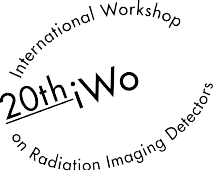Speaker
Description
We investigate the response of the Timepix detector for measurements and characterization of mixed fields such as radiation environments found in ion beam radiotherapy, Earth upper atmosphere and outer space. Of interest is the detector resolving power in terms of particle-type (species) and spectral- (energy loss) response. For this purpose we performed tests and calibration of detection response in defined fields of various radiations (electrons, protons, ions) at various energies and incident directions relative to the plane of the sensor. The signals produced (called pixel clusters) by single particles in the pixelated sensor are a convolution of (i) particle type (mass, Z), (ii) energy loss (stopping power, LET) and (iii) direction. The characteristic tracks in the form of pixel clusters are analysed at the pixel- and um-scale by so-called cluster analysis making use of high-resolution pattern recognition algorithms. Cluster parameters are analysed separately and also in correlations or ratios in the form of 2-dimensional plots (see Fig. 1). A resulting physics-based classification of event types is proposed in terms of radiation components (particle species, namely X-rays, light and charged particles), spectral/stopping power (dE/dx, LET spectra over several bins in semi-log range) and direction (limted angular resolution). Up to eight groups of events are distinguished with varying extent of range and partial overlap. Research supported by OP RDE, MEYS, Czech Republic under the project CRREAT, CZ.02.1.01/0.0/0.0/15_003/0000481. R&D of the WidePIX 3D instrument was supported by the project TACR TA04011329 of the Czech Republic.
Figure 1. (a) Two-dimensional correlated plots (event histograms) according cluster analysis parameters (shown HEA = Height to Elevation Angle, and LET = Linear Energy Transfer) for (a) electrons, (b) protons and ions: (c) 4He and (d) 12C at indicated energies and incident angles.
